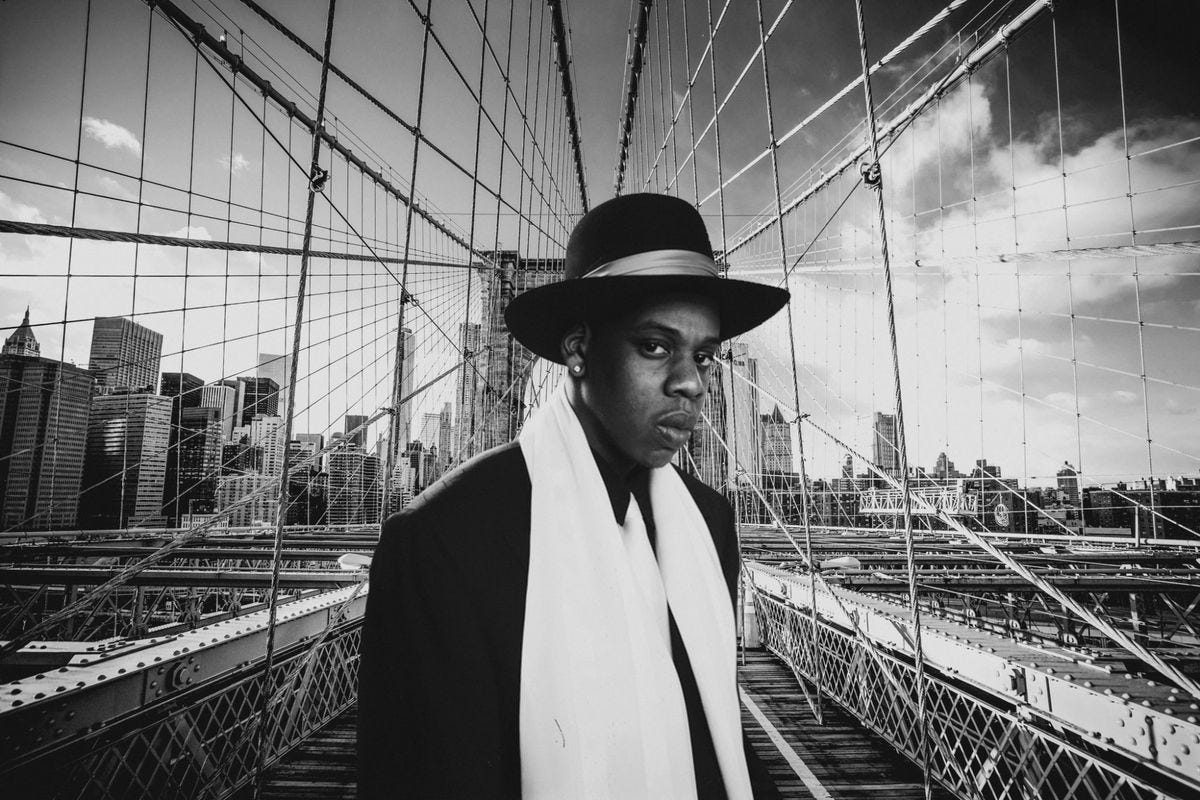Nearly thirty years after its release, Jay-Z’s debut LP ‘Reasonable Doubt’ has withstood the test of time, demonstrating for generations what a rap record is capable of – and earning its place as the greatest rap album of all time.
Stream: ‘Reasonable Doubt’ – Jay-Z
Reasonable Doubt is the greatest rap album of all time.
Shawn Carter, Jay-Z, was born in 1969. He didn’t have his breakthrough until 1996, geriatric by hip-hop standards. This age gave him a discerning presence in a young man’s game. He had many guest verses and had toured with some legends, but there were much grander inner workings and lofty ambitions brewing in Carter’s young mind. Jay seemed calmer, cooler, and more experienced than his counterparts.
The New Yorker described Carter’s rapping as “steely,” “precise,” “clear,” and “effortless,” in a 2001 article about Jay capitalizing on the commercialization of hip-hop. I won’t go into details about Jay’s life growing up in the Marcy projects in Brooklyn, as he has already done so extremely well throughout his illustrious two-and-a-half-decade career (half the age of the genre itself).

Rap has seen many evolutions throughout its 50-year history, starting with Kool Herc in the South Bronx in the 1970’s. Sugarhill Gang’s “Rappers Delight” introduced the genre to the masses in 1980, with a fun upbeat number that you could dance along to with your grandmother, as long as she wasn’t paying too close attention to the lyrics.
Everybody go:
Hotel, motel, whatcha gonna do today (Say what?)
‘Cause I’ma get a fly girl,
gonna get some spank and drive off in a def OJ
Everybody go: Hotel, motel, Holiday Inn
You see, if your girl starts
acting up, then you take her friend
Pure Americana bliss.
Things took off in the ’80s with Run-D.M.C., Eric B & Rakim, DJ Jazzy Jeff and the Fresh Prince, The Beastie Boys, and NWA – five distinct voices that paved the way for the next generation of rappers to explore different paths and avenues in the genre. Run DMC and the Beastie Boys blended rock n’ roll and hip-hop to create songs that crossed into the mainstream. Fresh Prince was a master G-rated storyteller who created a more palatable music experience for suburban parents who were wary of the genre. Eric B. and Rakim brought dynamic instrumentals and multisyllabic raps that treated the art form as a skill to be mastered, like playing the guitar. NWA took things to the next level, offering a glimpse into the harsh realities of a culture that people outside of this world had either neglected, shielded themselves from, or shunned.
By the 1990s, hip-hop was a mainstay in the mainstream musical landscape.
Master musicians created beautiful soundscapes out of hardships in the neglected urban centers that captured their lives and times on stereo. “The Golden Age of Hip-Hop” is the period between the mid-1980s to the mid-’90s. A lot of the genre’s greatest albums were released during this period, including the timeless work of art that is Reasonable Doubt.
When listening to and analyzing Reasonable Doubt, it helps to put it in this context, because nowadays Jay-Z is as ubiquitous to the music industry as Tom Brady is to football. At the time of releasing Reasonable Doubt, Jay was a relatively unknown rapper from Brooklyn who was looking to put his experiences in the Marcy Projects on vinyl.
* * *

Reasonable Doubt is flawless. It is a graduate thesis in rap precision and storytelling.
It is Shakespearean in scope and depth. It is a sleek and understated luxury vehicle that may pass you by without a second glimpse if you are not paying careful attention. Jay’s rapping is intimate and personal, yet dissociative. He is heartless but loving. His actions may be unpredictable. He has the business acumen of a CEO, command of the English language like Hemmingway — the lyrics are icebergs, it is up to the listener to go under the surface to find the several layers of meaning—insight into the human psyche of a psychologist, and unfazed delivery like Mahomes in the pocket. The production, primarily done by DJ Premier, Knobody, and DJ Clark Kent recalls the pre-gangster era of hip-hop, where samples and turntables reigned supreme.
The term “Reasonable Doubt” is typically used in a courtroom when a jury cannot determine whether a defendant is guilty. Thus, the album is on trial. The album cover is in black and white. Carter is holding a baseball-bat-sized cigar, a top hat, and either a scarf or a durag draped around his neck. The top half of his face is hidden from view, but we can see a straight face beneath his nose. He is wearing a suit. The man is all business. He is not here for games, for accolades, Shawn Carter is going to put in on wax and then carry on with his gangster lifestyle. Not your average street hustler. We’re talking Kingpins – Paul Castellano, John Gotti (more on him later), James Conway, Vito Corleone, and Tony Soprano.
There is much lore surrounding Jay’s songwriting process. He doesn’t write anything down. Supposedly, he thought of his lyrics while standing on street corners selling drugs. If he were rapping like an average artist, short bars about violence and luxury, this wouldn’t seem like such a feat. But he is not. He is creating motion picture scripts. He is imagining a world for himself far from his own. And he is going to build an empire for himself. Whether through rap, hustling, or whatever else it takes.

The album’s opener, “Can’t Knock the Hustle” is Jay showing off the glitz and glamor that went into the making of Reasonable Doubt. To go from hustling on the streets to grinding it out with guest appearances on other rapper’s songs, to having Mary J. Blige on your debut album’s opening track is something. Mary J Blige appeared on the single as a favor to Dame Dash, one of Jay’s partners at Roc-A-Fella Records, the record label that Jay, Dash, and Kareem Burke founded after Carter was rejected by other labels. Blige (and all the other guests on the album) received her compensation in the form of $10,000 cash in a paper bag. Counter-intuitively, the hustle that Jay is referring to in the song is not the streets, it is the music business. He didn’t want his colleagues in the game to clown him for trying to pursue this little rapping hobby.
Fittingly, the track opens with a scene from Scarface in which a character offers Tony Montana some crack to sell. Using a scene from a movie is apt because Carter is creating the soundtrack for his life. It is not the life of small-timing amateurs. This is for the veterans. His life is a movie. Furthermore, the scene is a metaphor for Jay’s music career. He is taking the plunge to start selling his music. The first verse begins with Jay proclaiming “I’m making short-term goals when the weather folds/Just put away the leathers and put ice on the gold.” It is important to take note of how Jay can make the most benign happenstance sound so f*ing cool. He’s making short-term goals, something that everybody who aspires to any sort of success has done. Not that cool. But to say when the weather folds in reference to the changing of a season is incredible. He put away the leathers because he had a business meeting. He can’t have drug particles flying off his person in an important meeting.
The double, triple, and quadruple entendres ensue throughout the verse. “Chilly with enough bail money to free Big Willie/High stakes, I got more at stake than Philly.” Big Willie can refer to a drug dealer, but it could also refer to Will Smith, who is from Philadelphia, famous for the cheesesteak, but Jay has more at stake than the whole city. Clearly. Hard to resist going further into lyric analysis, but I’ll stop there. Even Jay had to stop, most of his lyrics were going over people’s heads, and he admits to having dumbed down his lyrics to appeal to a more mainstream audience. He is not just a businessman, he is a business, man.
What makes everything flow so well is the fluidity with which it is delivered, perhaps thanks to the 10,000 hours of rehearsal time that Jay had on street corners. The Beatles had Hamburg, Jay had Marcy and Myrtle. Carter is not rapping about the opulent luxury that you hear about nowadays, even though I am sure he has surpassed any goals he had thought of in his wildest imagination. But, rather, in 1996, he is driving a souped-up Lexus or BMW. He is playing at high-stakes poker tables. He refers to wheels as “socks,” and it makes sense.
The second track, “Politics as Usual” is a reference to street politics which dictated Jay’s day-to-day lifestyle. He spent a lot of time driving between towns and neighborhoods. Picking up packages in Jersey, battle-rapping Big L in Harlem, and taking over city blocks with his operation. He spends his money on jewelry, gambling, and luxurious vacations. He doesn’t have time for a fancy hook, it is just there to let you know it is “politics as usual.” Let the beat build. Let the strings bring us home.
The second verse opens with Jay taking his “Frito to Tito in the district.” The way it rolls off his tongue is so smooth. (Frito is chips, chips is money, Tito is a jeweler in the Diamond District.) Jay chops up syllables like a Summa Cum Laude student at the Culinary Institute. “I’m smokin’ bros who pump Willie, I expose/The furthest you Chiles been is the Poconos.” There is a lot here, Chilly willy is a cartoon penguin. Willie is a positive nickname, however, if you pump willie you are faking it. Chile beans. The farthest they’ve been is the Poconos, which is like a two hour drive from Brooklyn. Jay takes a flight to Vegas to gamble on a Tyson fight for the tax write off and is back on the same night. He’s dunking on fools all over the place, and it doesn’t even sound like he’s trying.
“Brooklyn’s Finest” is Superman and Batman, Kobe and Lebron, Djokovic and Federer, in collaboration, trading bar for bar. Jay and Big are seamlessly bouncing off one another. Jay put down his lyrics on the verse first, which is evident by Big’s ad-libbing on Jay’s bars, but Jay’s voice is rarely heard on Big’s verses. The song is still a 10/10. Mostly for the standout lyrics like, “But on the con-trilli, I packs the MAC-milli/Squeezed off on him, left them paramedics breathin’ soft on him” Con-trilli is not even close to a word, but you know exactly what it means when Jay drops it in the verse.
Jay and Big were classmates once upon a time and the chemistry they have as friends is evident. They are trying to outshine each other. Big was coming off the critical acclaim of Ready to Die, and Jay was trying to match his colleague’s success. Although Reasonable Doubt did not match the initial commercial or critical acclaim of Ready to Die, both albums cast a long legacy over the rap game. And, perhaps more importantly for Carter at the time, he held his own with who is considered one of the greatest rappers of the time.
“Dead Presidents II” is actually the second song that Jay recorded over the same beat. “Dead Presidents” was initially going to be a single on Reasonable Doubt, but it was scrapped and Carter recorded another whole ass song on the beat. The man had raps oozing out of him. Ski Beatz produced the song, and it is the epitome of 90’s New York boom bap rap that smacks you in the face.
The piano evokes emotions of a cold winter night. It is a horror movie, but Jay is unflappable. He is our conductor, overcoming the darkness of life. It is black and white, sleek cars driving by in slow motion. The song, notoriously, samples Nas saying “Dead f*in’ presidents to represent me.” A sample like that is interesting because everybody has certain lines on songs that stand out and imprint themselves on somebody’s memory. Six words can make a lifelong impact. The whole is greater than the sum of its parts.
Who wanna bet us that we don’t touch lettuce?
Stack cheddars forever, live treacherous, all the et ceteras
To the death of us, me and my confidants, we shine
You feel the ambiance, y’all just rhyme
By the ounce, dough accumulates like snow
We don’t just shine,
we illuminate the whole show, you feel me?
Factions from the other side would love to kill me
Spill three quarts of my blood into the street
Let alone the heat
“Feelin’ It” is a celebration. Jay deserves it. He has been through a lot. Mecca provides a lusty chorus that gives the song an old-school vibe. Like Mecca and Ski Beatz could have made the song in the 1930s and Jay just happened to be some virtuoso who walked into the speakeasy and hopped on the record to turn it into his triumph (Ski had originally produced the hook, melody, and beat for himself). Jay is real, he drinks Cristal, he wears fly clothes, he takes care of his friends. Jay is an optimist. “Even if it ain’t sunny, hey I ain’t complaining/I’m in the rain doing a buck 40, hydroplaning.” You don’t need to take Jay’s word for it, just ask one of the “girls that bought a girdle to conceal [his] bricks.” Say what you want about the man, his life was anything but boring.
With the sixth track, “D’Evils,” the album returns to the darker mood that runs through the album. DJ Premier is one of the greatest rap producers of all time, and he provides the perfect backdrop for the tragic themes on “D’Evils.” The minor piano keys on the track are downright evil. They sample a gospel record, the song is spiritual in its foundation and title. Jay specified the thematic samplings of Snoop Dogg and Prodigy of Mobb Deep he wanted to provide the backdrop in the song. Jay succumbs to the evils on this track. He is done trying to run. The lyrics are confessional and a description of “the mechanics and the workings of the underworld.” Followed by Jay playing an instrument with his rapping versatility, “Nine-to-five is how you survive, I ain’t tryna survive/I’m tryna live it to the limit and love it a lot.” He never prayed to God; he prayed to Gotti.
The first verse is an overview of how people may succumb to the lifestyle of evils and temptations. Verse two is when things turn truly dark. Jay explains how he must turn to violence on his childhood friend. Two kids that grew up together, learned to “use rubbers,” but in a twist of fate, his friend never truly learned so he is “kidnappin’ his baby’s mother.” He doesn’t want to do it, “In time I’ll take away your miseries and make it mine.” Despite the luxury, the Lexus’s and diamonds, tragedy and heartbreak overshadow the successes.

“22 Two’s” is Jay demonstrating his lyrical dexterity on a straightforward beat. Supposedly if you count how many times he says too, it’s twenty-two. It’s higher-level thinking and song construction and Jay doesn’t even sound like he’s trying. The woman speaking at the beginning and the end of the song was the host of an Emcee showcase where Jay used to pop in and drop this verse.
“Can I Live” is another all-time classic. The trumpets, the calm and smooth delivery, he can fit so much into one bar. His economy of words allows him to say so much with his precise bars. Even the title has such a layered meaning — “Can I live?” or will the feds or a rival come for him? Can he enjoy his success or people going to be out to get him? He knows it can’t be that simple. “Laughin’ hard happy to be escapin’ poverty, however brief/I know this game got valleys and peaks.”
Jay reflects on his turbulent upbringing and life decisions from the perspective of somebody twice his senior. It is another celebration, but with an undertone that things may end at any moment, Jay has no choice but to live this life, the intro describes how he does so out of a “sense of hopelessness.” The opening couplet speaks volumes about the depth of the song. “While I’m watching every watchin’ me closely / My shit is butter for the bread, they wanna toast me.” First, in terms of the drug game, he is keeping his eye out for people who are getting a little too close for comfort, his drug sales make him “butter for the bread” thus his enemies want to smoke (kill) him like toast. Or, it could be a reference to his fans who are at his live shows, he’s on high alert even though they want to say a toast for him. These are just the opening two bars!
The following track, “Ain’t No N—” (or “Ain’t No Playa,” a reference to Four Tops “Ain’t No Woman (Like the One I’ve Got)”) is not a love song, rather it’s a song about a no-strings relationship. It’s a man and woman, Foxy Brown, in their twenties that are getting their first taste of success and are celebrating with extravagant purchases and travel across the country. This is actually one of the songs that helped to put Shawn Carter on the map, thanks to a cameo from Biggie in the video and none other than the one and only Nutty Professor. Foxy Brown carries her own on this track as well, matching Jay’s lyrics with her own bragadocious and smooth delivery. She is aware that she is dating a womanizer, she just wants to make sure that he keeps her “laced in the illest snakes,” because she was there when he was just getting started. Compared to the other tracks on the album, this one is not as complex and layered with meaning. Rather, it is straightforward, fun, funky, and good to dance to thanks to the groovy bass line.
“Friend or Foe” is my favorite track on the album for its vivid story telling and narrative perspective. It feels like a scene straight out of Pulp Fiction or The Wire. Jay’s flow is one-of-one, incomparable, and unable to be replicated. Jay doesn’t dumb it down here for his audience, he puts us directly into the middle of the action and it’s up to us to catch up. Jay is sizing up a fellow “enterprisin’” hustler who is encroaching on Jay’s territory. It’s incredible because he is being very respectful while also threatening to murder this foe. It also gives us insight into how much of a kingpin Jay truly is at this point, he’s got kids on the block working for him, he doesn’t carry weapons, his crew does that for him. He is so nonchalant and calm about the whole situation. It’s life or death and he has the demeanor as if he is ordering a sandwich. The genuineness of his delivery is what makes the song so engaging.
The eleventh track, “Coming of Age” is another narrative, this time about Jay mentoring a young man in the art of dealing. Memphis Bleek is eight years Jay’s junior, which helps to make the song sound authentic. Their perspectives in the song perfectly parallel one another, Jay sounds like a wisened veteran that is looking to “relive my days of youth” while Memphis is simply trying to “add a couple of dollar signs to my name.” Jay and Memphis Bleek went on to become long-time collaborators, with Jay acting as Bleek’s mentor throughout his career. This is more than life imitating art, there relationship is art personified.
“Cashmere Thoughts” is one of the more light-hearted tracks on Reasonable Doubt, as evident by the opening jabs between Jay and producer Clark Kent. The song is about how Jay-Z’s life is an embodiment of the finer things. Jay’s “voice is linen.” He even has “the cashmere Chromosomes” because he is so fly that even his genetic makeup is luxurious. He writes raps with his “18-carat gold pen.” He was one of the first rappers to flex platinum.
DJ Premier provides an absolute banger of a beat that epitomizes the ’90s era New York hip-hop sound on “Bring It On.” Jaz-O (The Jaz, Big Jaz) and Sauce Money fit perfectly on the record, but so would Nas, Mobb Deep, Big L, or any other East Coast rapper. The song was originally supposed to feature Nas, but he kept flaking on the sessions, so they said forget it and decided to record the track without him.
Jaz-O is also from the Marcy projects, and he acted as Jay-Z’s mentor, similar to Jay-Z’s relationship with Memphis Bleek. It is awesome to hear Jaz-O and Jay on the same track because you can hear Jaz’s influence on Jay-Z based on their rhyming styles. Jaz-O brings the heat on the track, fittingly providing the best verse of the three. Jaz is said to be one of the originators of the triplet flow that Jay and countless other rappers have co-opted, allowing for more syllables to be jammed into the traditional 4/4 time signature of most hip-hop tracks. Unfortunately, Jay had a falling out with Jaz (and Sauce Money) due to a record contract dispute, but the two reconciled a couple of decades later.

“Regrets” closes out the original release of Reasonable Doubt with a retrospective on the difficulties that a gangster has to make. Again, Jay raps from the perspective of somebody far wiser than his age. Jay is a product of his environment, of course he has countless regrets and some dark skeletons in his closet, but he has to keep moving forward. His ability to acknowledge and compartmentalize his decisions is one of his strongest attributes not only as a rapper but as an individual. While Jay does glamorize the life of a drug dealer, he also paints a vividly honest portrait. Having to betray and murder lifelong friends. Acknowledging that his time at the top will likely be short. Selling drugs to vulnerable individuals, it hurts, he “don’t wanna see ‘em.”
Jay-Z has had a tougher upbringing than ninety-nine percent of his listeners, and has had to do some dishonorable things in the process, but the chorus of the song offers a valuable lesson to everybody no matter where you come from. Everybody has regrets, what’s important is how you deal with them. You can learn from them and forgive yourself, or you can fixate on them and let them define you. This is the perfect ending to the album, because it shows that despite all the glamour and glitz, the near-brushes with death, the success that he has ultimately attained, it has come with a lifetime of regrets. Yet, he continues forward, as he wants his listeners to do.
— —
:: connect with Jay-Z here ::
— — — —

Connect to Jay-Z on
Facebook, Twitter, Instagram
Discover new music on Atwood Magazine
© Roc-A-Fella Records
Reasonable Doubt
an album by Jay-Z


 © Roc-A-Fella Records
© Roc-A-Fella Records





